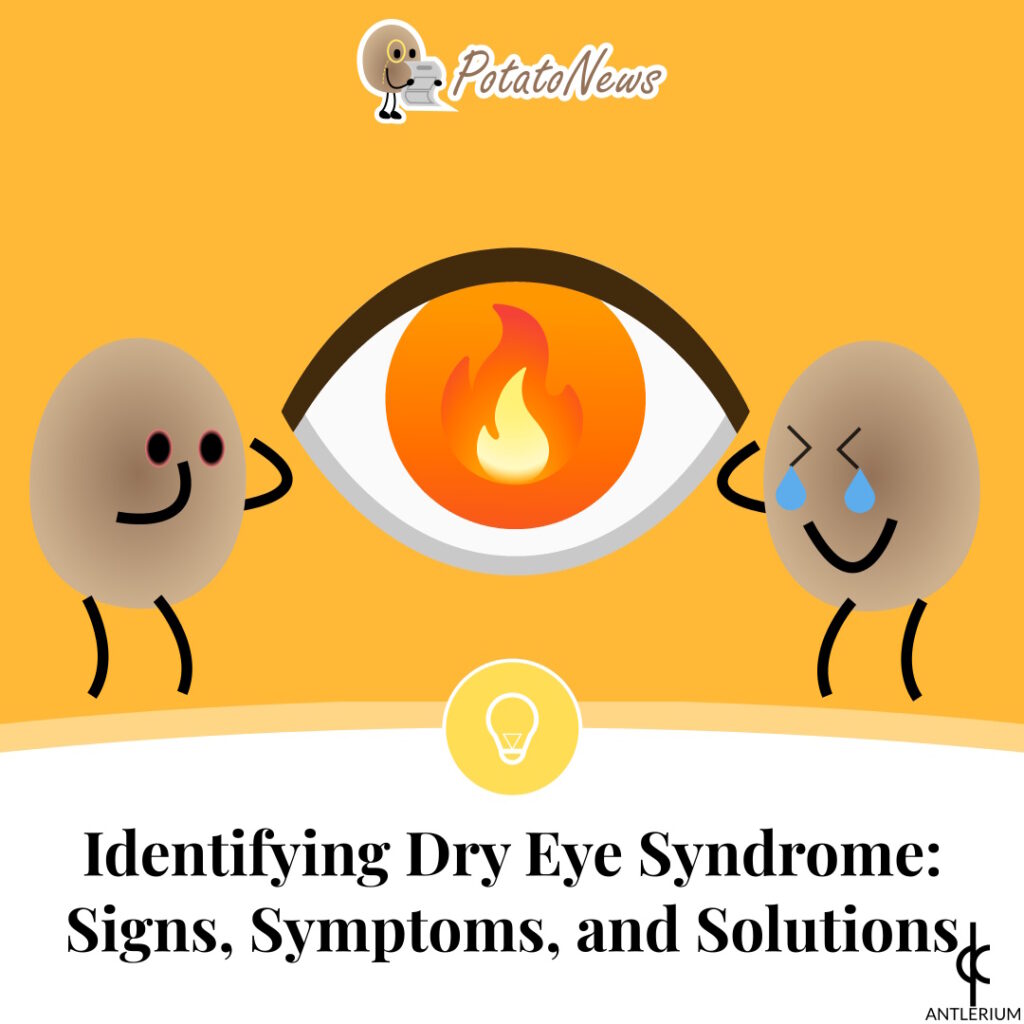Identifying Dry Eye Syndrome: Signs, Symptoms, and Solutions
Dry eye syndrome, also known as keratoconjunctivitis sicca, is a common condition that occurs when your eyes do not produce enough tears or when the tears evaporate too quickly. It can cause discomfort, vision problems, and impact your overall eye health.
This is a very common problem in our generation. We are exposed to computer screens and smartphone screens. The more we use these digital devices, the more likely we get our eyes dry.
In this article, we will explore how to identify dry eye syndrome by recognizing its signs and symptoms, as well as provide some solutions to alleviate the discomfort.
This is Antlerium PotatoNews, a series focusing on the daily lives of ordinary people, including life tips. Today we explore dry eye syndrome.

Signs and symptoms of dry eye syndrome
Dry eye syndrome can manifest in various ways. Here are some common signs and symptoms to watch out for:
Dryness and irritation
You may experience a persistent dry and gritty sensation in your eyes, as if there's something stuck in them.
Redness
Dry eyes may appear red and bloodshot due to irritation and inflammation.
Burning or stinging sensation
Some individuals with dry eye syndrome report a burning or stinging feeling in their eyes.
Watery eyes
Paradoxically, dry eyes can trigger excessive tearing as your eyes attempt to compensate for the lack of moisture.
Blurred Vision
Your vision may become blurry, particularly after prolonged periods of reading, using digital devices, or performing visually demanding tasks.
Sensitivity to light
Dry eyes can make your eyes more sensitive to light, causing discomfort in bright environments.
Eye fatigue
You may experience eye fatigue, especially during activities that require intense visual concentration.
Difficulty wearing contact lenses
Dry eye syndrome can make wearing contact lenses uncomfortable, leading to increased irritation and lens intolerance.
Solutions for dry eye syndrome
If you suspect you may have dry eye syndrome, here are some solutions that can help alleviate the discomfort and manage the condition:
Artificial tears
Over-the-counter artificial tear drops or lubricating eye drops can provide temporary relief by moisturizing your eyes. Use preservative-free drops for long-term use. For more information, I recommend to read the article from Cleveland Clinic.
Warm compresses
Apply a warm compress to your closed eyes for a few minutes. This can help stimulate tear production and relieve dryness.
Blinking exercises
Make a conscious effort to blink regularly, especially when using digital devices or performing tasks that require focused attention. Blinking helps distribute tears across the eye surface.
Humidify your environment
Use a humidifier in your home or office to add moisture to the air, reducing the evaporation of tears.
Avoid environmental triggers
Minimize exposure to dry or windy environments, as well as smoke and air pollutants, which can exacerbate dry eye symptoms.
Take screen breaks
If you have to spend a long period using digital devices, follow the 20-20-20 rule—look away from the screen every 20 minutes and focus on an object 20 feet away for 20 seconds. This helps reduce eye strain and dryness.
Stay Hydrated
Drink an adequate amount of water throughout the day to maintain overall hydration, which can contribute to eye moisture.
Check out our article about hydration as a reference to figure out how much water you should drink every day.
Consult an eye care professional
Seek medical advice in case you afraid that your symptoms persist or worsen. See an eye care professional who can evaluate your condition and provide further guidance and treatment options.
Dry eyes matter! If you have it, cure it!
Dry eye syndrome can be a bothersome condition, but with proper identification and management, you can find relief and protect your eye health.
By recognizing the signs and symptoms of dry eye syndrome and implementing the suggested solutions, you can mitigate discomfort, improve lubrication, and enhance your overall eye well-being.
Remember, if your symptoms persist or become severe, seeking professional advice is essential for a proper diagnosis and tailored treatment plan.
This is how you identify and heal from dry eye syndrome. To learn more about life tips or other topics related to our ordinary life, make sure to follow PotatoNews. We will also post some cliffsnotes on our socials, make sure to follow them.
Similar articles
- 👁️ 7 Eye Exercises To Improve Vision, Easy And Effective
- 🚰 Optimal Water Intake for Daily Hydration: Understanding How Much Water You Should Drink
- 🚰 Stay Hydrated: Your Guide to Beating Dehydration
- 🚱 How Dehydration Affects Cognitive Function And Physical Performance
- 🥑 The Keto Diet: A Simple Guide to Achieving Your Health Goals
- 🥑 The Ultimate Keto Food Guide: What to Eat for Optimal Health and Weight Loss
- 🥛 Drink Milk Can Get Sick? How To Identify Lactose Intolerance
- ☕ Stopping Coffee Might Be the Best Decision